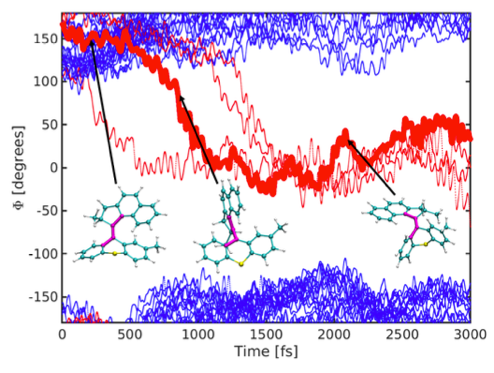Talk #D4.07
24.05.2024, 14:30 – 15:00
Computational design of light-driven molecular nanomotors
Light-driven molecular nanomotors (MNMs) [1] convert light into mechanical energy. Due to their temporal and spatial controllability, MNMs have several potential applications in biomedical sciences, including drug delivery and permeabilization of membranes [2]. Improving their efficiency requires optimization of various molecular properties. Above all, a high product quantum yield (PQY) [3] for the photochemical isomerization that drive the conversion of photon energy into mechanical work is needed. This typically goes in hand with a high absorption cross section. Due to improved tissue penetration, near-IR light is the desired source of energy. However, due to the excitation energy required to drive the isomerization, this often requires usage of two-photon absorption. Based on quantum chemistry and ab initio non-adiabatic molecular dynamics [4], I will report efforts to design new MNMs with improved PQY, one- and two-photon absorption cross sections. To allow screening of a large number of molecular candidates, machine learning methods for the prediction of excited state properties [5, 6] take a crucial role in this development.

Figure 1. Photoinduced isomerization of a unidirectional MNM, simulated by ab initio non-adiabatic molecular dynamics.
- N. Koumura, E. M. Geertsema, A. Meetsma, and B. L. Feringa, J. Am. Chem. Soc. 2000, 122(48), 12005–12006.
- V. García-López, F. Chen, L. G. Nilewski, G. Duret, A. Aliyan, A. B. Kolomeisky, J. T. Robinson, G. Wang, R. Pal, and J. M. Tour, Nature 2017, 548(7669), 567.
- T. Thompson and E. Tapavicza, J. Phys. Chem. Lett. 2018, 9(16), 4758–4764.
- E. Tapavicza, G. D. Bellchambers, J. C. Vincent, and F. Furche, Phys. Chem. Chem. Phys. 2013, 15, 18336–18348.
- R. Ramakrishnan, M. Hartmann, E. Tapavicza, and O. A. von Lilienfeld, J. Chem. Phys. 2015, 143(8), 084111.

Enrico Tapavicza
- Department of Chemistry and Pharmacy, University Regensburg, Germany
- Department of Chemistry and Biochemistry, California State University, Long Beach, USA